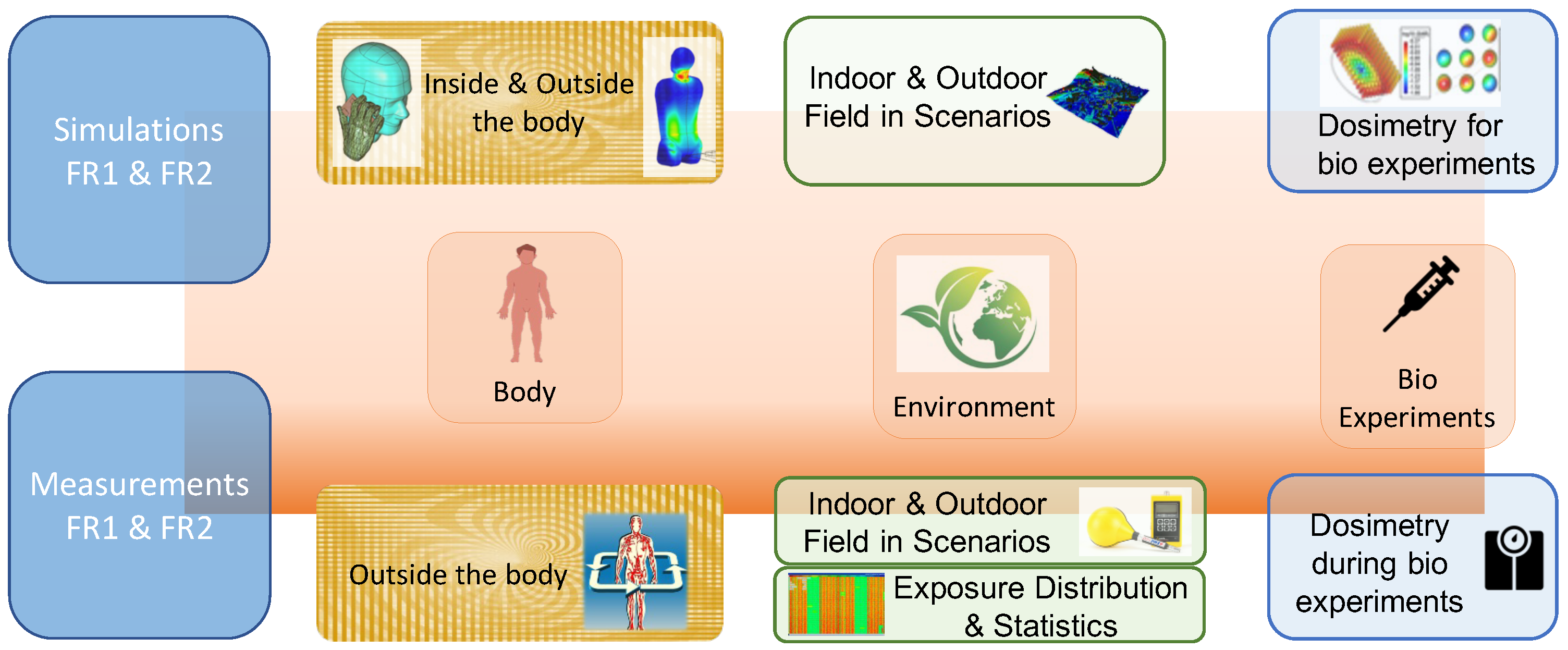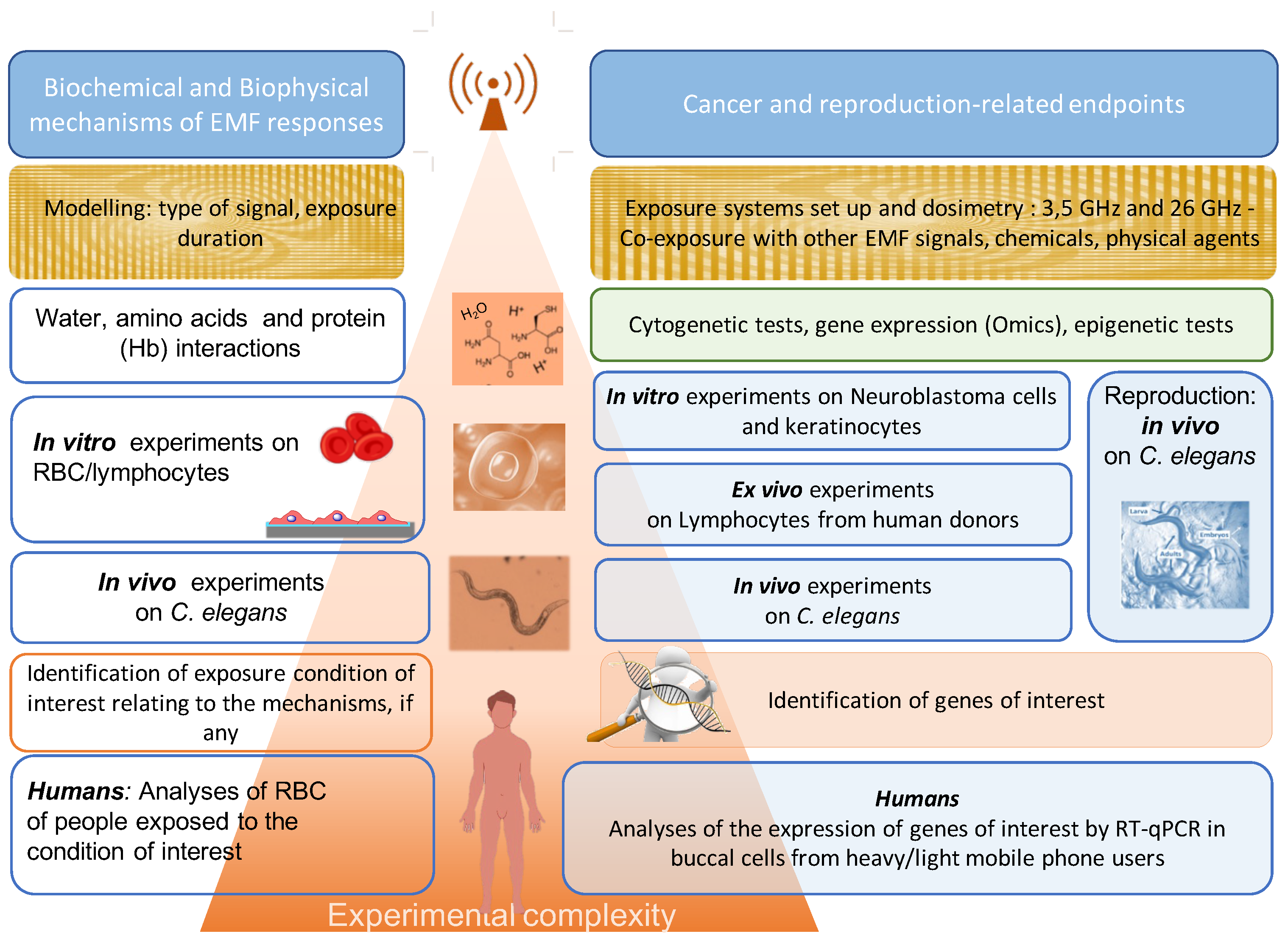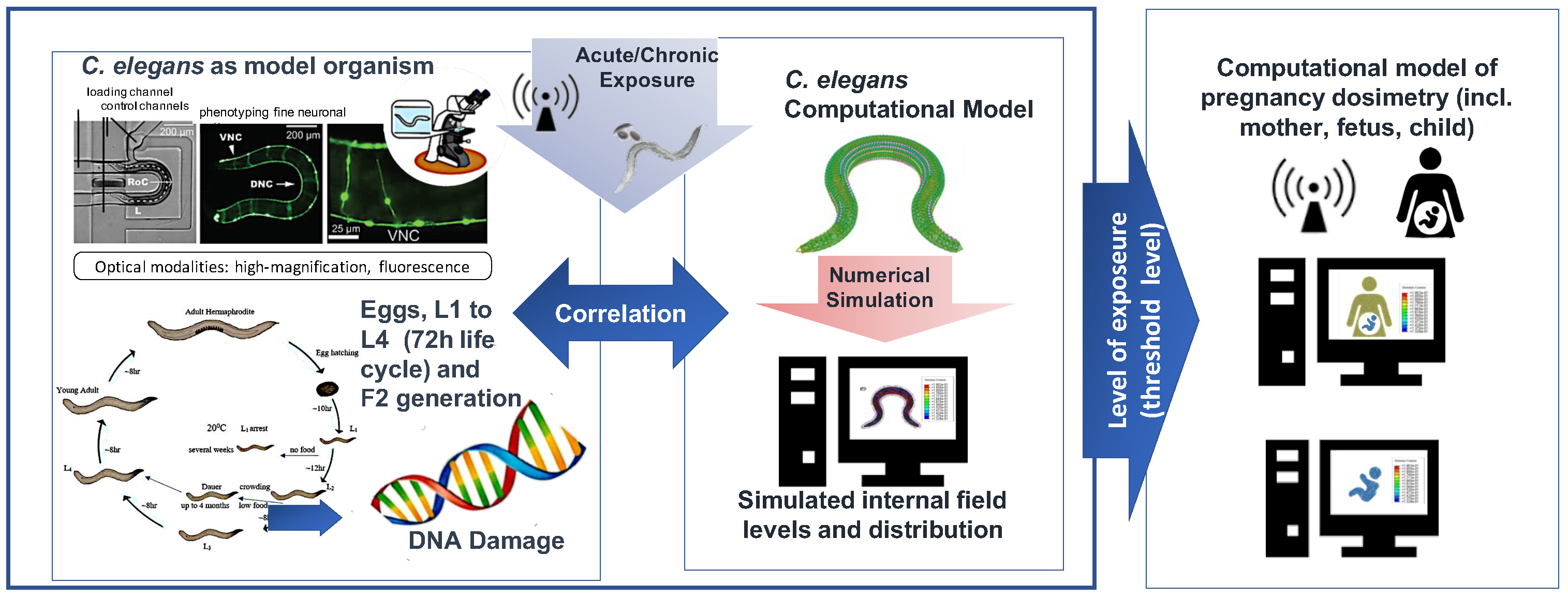NextGEM: Next-Generation Integrated Sensing and Analytical System for Monitoring and Assessing Radiofrequency Electromagnetic Field Exposure and Health
Abstract
:1. Introduction
- Updated appraisal of the scientific evidence regarding possible links between RF-EMF and health effects for (i) the general public, (ii) workers, and (iii) vulnerable groups to aid public authorities in implementing evidence-based policies, risk assessment, and communication.
- Quality criteria, standards, and methodologies (i) to assess RF-EMF exposure and health effects, and (ii) for biological investigations fulfilling the 3R (Replace, Reduce, and Refine) standards.
- Understanding interaction mechanisms between RF-EMF and biological systems, including combined exposures with other agents and multiple signals.
- Adequate scientific communication to improve awareness among authorities, employers, and citizens, counteracting RF-EMF misinformation.
2. Related Activities
2.1. 5G Exposure Patterns
2.2. RF-EMF Modelling Tools
2.3. Physics of the Processes Initiated by Exposure of Living Cells to RF-EMF
2.4. In Vitro and In Vivo Investigations
2.5. Human Studies
2.6. Umbrella Review of Neoplasia Risks from RF-EMF Exposure in Humans
2.7. Health Risk Assessment
3. Methodology
3.1. The NextGEM Project Methodological Approach
- Sensing and data source: Data for RF-EMF exposure assessment will be collected from the literature and/or experimentally measured in different real-life scenarios through the case studies conceived and developed during the project. As regards the new generation communication networks, novel measurement paradigms aim to be developed together with wearable sensing devices suitable for the 5G mm wave band.
- Analytics and experimentation: The combination of multiple approaches from real-life case scenarios, exposure assessment, and umbrella reviews of epidemiological data in combination with in vitro, ex vivo, and in vivo experiments elucidates possible biological and health effects of RF-EMF interactions and their underlying mechanisms.
- Applications, tools, and services: NextGEM will provide novel exposure assessment devices and protocols as well as risk assessment tools, integrated into the NIKH, representing the main key exploitable outcomes.
3.2. RF-EMF Exposure Assessment Modeling and Measurements
3.3. Experimental Studies
3.4. Causal Links between RF-EMF Exposure Level and Duration and Potential Health Effects
3.5. Development of NextGEM Innovation and Knowledge Hub
4. Case Studies
4.1. Case Study 1—Potential Effects of Indoor Levels of RF-EMF Exposure of Vulnerable People on Reproduction and Development
4.2. Case Study 2—Optimised Outdoor Urban Planning and 5G Design Architecture and Investigations for Public Awareness on Cancer-Related Health Hazards
4.3. Case Study 3—Health Effects of Exposure to RF-EMF in Indoor and Outdoor Environments
4.4. Expected Outcomes from Case Studies
5. Conclusions
Author Contributions
Funding
Conflicts of Interest
References
- ICNIRP. Guidelines for limiting exposure to time-varying electric, magnetic, and electromagnetic fields (up to 300 GHz). Health Phys. 1998, 74, 494–521. [Google Scholar]
- European Union. Directive No. 2013/35/EU, of 26 June 2013, on the Minimum Health and Safety Require-Ments Regarding the Exposure of Workers to the Risks Arising from Physical Agents (Electromagnetic Fields). Off. J. Eur. Union 2013, L179, 1–21. Available online: http://eur-lex.europa.eu/legal-content/EN/TXT/PDF/?uri=CELEX:32013L0035&from=PT (accessed on 1 March 2023).
- 1999/519/EC: Council Recommendation of 12 July 1999 on the Limitation of Exposure of the General Public to Electromagnetic Fields (0 Hz to 300 GHz). Available online: https://eur-lex.europa.eu/legal-content/EN/TXT/?uri=celex:31999H0519 (accessed on 1 March 2023).
- Types of Legislation, European Commission. Available online: https://european-union.europa.eu/institutions-law-budget/law/types-legislation_en (accessed on 1 March 2023).
- Stam, R. Comparison of International Policies on Electromagnetic Fields: Power Frequency and Radiofrequency Fields; National Institute for Public Health and the Environment (RIVM): Bilthoven, Utrecht, 2018.
- IEC/IEEE 62209-1528-2020; Measurement Procedure for the Assessment of Specific Absorption Rate of Human Exposure to Radiofrequency Fields from Hand-Held and Body-Mounted Wireless Communication Devices. International Organization for Standardization (ISO): Geneva, Switzerland, 2020.
- IEC/TR 62669:2019; Case Studies Supporting IEC 62232—Determination of EMF Field Strength, Power Density and SAR in the Vicinity of Radiocommunication Base Stations for the Purpose of Evaluating Human Exposure. International Electrotechnical Commission: Geneva, Switzerland, 2019.
- Otin, R. ERMES: A nodal-based finite element code for electromagnetic simulations in frequency domain. Comput. Phys. Commun. 2013, 184, 2588–2595. [Google Scholar] [CrossRef]
- Schwan, H.P. Electrical properties of tissue and cell suspensions. Adv. Biol. Med. Phys. 1957, 5, 147–209. [Google Scholar]
- Raicu, V.; Feldman, Y. (Eds.) Dielectric Relaxation in Biological Systems: Physical Principles, Methods, and Applications; Oxford University Press: New York, NY, USA, 2015. [Google Scholar]
- Asami, K. Characterization of heterogeneous systems by dielectric spectroscopy. Prog. Polym. Sci. 2002, 27, 1617–1659. [Google Scholar] [CrossRef]
- Stücker, M.; Struk, A.; Altmeyer, P.; Herde, M.; Baumgärtl, H.; Lübbers, D.W. The cutaneous uptake of atmospheric oxygen contributes significantly to the oxygen supply of human dermis and epidermis. J. Physiol. 2002, 538, 985–994. [Google Scholar] [CrossRef]
- Darvishi, M.; Mashati, P.; Kala, S.; Paridar, M.; Takhviji, V.; Ebrahimi, H.; Zibara, K.; Khosravi, A. Electromagnetic radiation: A new charming actor in hematopoiesis? Expert Rev. Hematol. 2021, 14, 47–58. [Google Scholar] [CrossRef]
- Mousavy, S.J.; Riazi, G.H.; Kamarei, M.; Aliakbarian, H.; Sattarahmady, N.; Sharifizadeh, A.; Safarian, S.; Ahmad, F.; Moosavi-Movahedi, A.A. Effects of mobile phone radiofrequency on the structure and function of the normal human hemoglobin. Int. J. Biol. Macromol. 2009, 44, 278–285. [Google Scholar] [CrossRef]
- Obajuluwa, A.O.; Akinyemi, A.J.; Afolabi, O.B.; Adekoya, K.; Sanya, J.O.; Ishola, A.O. Exposure to radio-frequency electromagnetic waves alters acetylcholinesterase gene expression, exploratory and motor coordination-linked behaviour in male rats. Toxicol. Rep. 2017, 4, 530–534. [Google Scholar] [CrossRef]
- Simkó, M.; Remondini, D.; Zeni, O.; Scarfi, M.R. Quality matters: Systematic analysis of endpoints related to “cellular life” in vitro data of radiofrequency electromagnetic field exposure. Int. J. Environ. Res. Public Health 2016, 13, 701. [Google Scholar] [CrossRef] [Green Version]
- Lamkowski, A.; Kreitlow, M.; Radunz, J.; Willenbockel, M.; Sabath, F.; Schuhn, W.; Stiemer, M.; Fichte, L.O.; Dudzinski, M.; Böhmelt, S.; et al. Gene expression analysis in human peripheral blood cells after 900 MHz RF-EMF short-term exposure. Radiat. Res. 2018, 189, 529–540. [Google Scholar] [CrossRef] [PubMed]
- SCENIHR: Scientific Committee on Emerging and Newly Identified Health Risks. Opinion on Potential health effects of exposure to electromagnetic fields. Bioelectromagnetics 2015, 36, 480–484. [Google Scholar] [CrossRef]
- Revanth, M.P.; Aparna, S.; Madankumar, P.D. Effects of mobile phone radiation on buccal mucosal cells: A systematic review. Electromagn. Biol. Med. 2020, 39, 273–281. [Google Scholar] [CrossRef] [PubMed]
- De Oliveira, F.M.; Carmona, A.M.; Ladeira, C. Is mobile phone radiation genotoxic? An analysis of micronucleus frequency in exfoliated buccal cells. Mutat. Res. Toxicol. Environ. Mutagen. 2017, 822, 41–46. [Google Scholar] [CrossRef] [PubMed]
- Verschaeve, L. Genetic damage in subjects exposed to radiofrequency radiation. Mutat. Res. Mutat. Res. 2009, 681, 259–270. [Google Scholar] [CrossRef] [PubMed]
- Whaley, P.; Aiassa, E.; Beausoleil, C.; Beronius, A.; Bilotta, G.; Boobis, A.; de Vries, R.; Hanberg, A.; Hoffmann, S.; Hunt, N.; et al. Recommendations for the conduct of systematic reviews in toxicology and environmental health research (COSTER). Environ. Int. 2020, 143, 105926. [Google Scholar] [CrossRef]
- Lagorio, S.; Blettner, M.; Baaken, D.; Feychting, M.; Karipidis, K.; Loney, T.; Orsini, N.; Röösli, M.; Paulo, M.S.; Elwood, M. The effect of exposure to radiofrequency fields on cancer risk in the general and working population: A protocol for a systematic review of human observational studies. Environ. Int. 2021, 157, 106828. [Google Scholar] [CrossRef]
- Farhat, N.; Al Ruwaili, H.; Gognac, P.; Habash, M.; Taher, M.; Sikora, L.; Habash, R.; Momoli, F.; Villeneuve, P.; Krewski, D.; et al. PROSPERO 2020 CRD42020202914. Available online: https://www.crd.york.ac.uk/prospero/display_record.php?ID=CRD42020202914 (accessed on 1 March 2023).
- Marques, M.M.; de Gonzalez, A.B.; Bel, F.A.; Browne, P.; Demers, P.A.; Lachenmeier, D.W.; Bahadori, T.; Barupal, D.K.; Belpoggi, F.; Comba, P.; et al. Advisory Group recommendations on priorities for the IARC Monographs. Lancet Oncol. 2019, 20, 763–764. [Google Scholar] [CrossRef]
- Simkó, M.; Mattsson, M.O. 5G Wireless Communication and Health Effects-A Pragmatic Review Based on Available Studies Regarding 6 to 100 GHz. Int. J. Environ. Res. Public Health 2019, 16, 3406, PMCID:PMC6765906. [Google Scholar] [CrossRef] [PubMed] [Green Version]
- Romeo, S.; Zeni, O.; Sannino, A.; Lagorio, S.; Biffoni, M.; Scarfì, M.R. Genotoxicity of radiofrequency electromagnetic fields: Protocol for a systematic review of in vitro studies. Environ. Int. 2021, 148, 106386. [Google Scholar] [CrossRef]
- Chartres, N.; Bero, L.A.; Norris, S.L. A review of methods used for hazard identification and risk assessment of environmental hazards. Environ. Int. 2019, 123, 231–239. [Google Scholar] [CrossRef]
- Scientific Committee on Health, Environmental and Emerging Risks (SCHEER), Memorandum on weight of evidence and uncertainties Revision 2018, Luxemburg, [Online]. Available online: https://health.ec.europa.eu/system/files/2019-02/scheer_o_014_0.pdf (accessed on 1 March 2023).
- Pinchera, D.; Migliore, M.; Schettino, F. Compliance boundaries of 5G massive MIMO radio base stations: A statistical approach. IEEE Access 2020, 8, 182787–182800. [Google Scholar] [CrossRef]
- Fall, A.K.; Besnier, P.; Lemoine, C.; Zhadobov, M.; Sauleau, R. Design and experimental validation of a mode-stirred reverberation chamber at millimeter waves. IEEE Trans. Electromagn. Compat. 2014, 57, 12–21. [Google Scholar] [CrossRef]
- Romeo, S.; D’Avino, C.; Pinchera, D.; Zeni, O.; Scarfì, M.R.; Massa, R. A waveguide applicator for in vitro exposures to single or multiple ICT frequencies. IEEE Trans. Microw. Theory Tech. 2013, 61, 1994–2004. [Google Scholar] [CrossRef]
- Thomas, P.; Holland, N.; Bolognesi, C.; Kirsch-Volders, M.; Bonassi, S.; Zeiger, E.; Knasmueller, S.; Fenech, M. Buccal micronucleus cytome assay. Nat. Protoc. 2009, 4, 825–837. [Google Scholar] [CrossRef] [PubMed]
- Dekkers, O.M.; Vandenbroucke, J.P.; Cevallos, M.; Renehan, A.G.; Altman, D.G.; Egger, M. COSMOS-E: Guidance on conducting systematic reviews and meta-analyses of observational studies of etiology. PLoS Med. 2019, 16, e1002742. [Google Scholar] [CrossRef]
- Verbeek, J.; Oftedal, G.; Feychting, M.; van Rongen, E.; Scarfì, M.R.; Mann, S.; Wong, R.; van Deventer, E. Prioritizing health outcomes when assessing the effects of exposure to radiofrequency electromagnetic fields: A survey among experts. Environ. Int. 2021, 146, 106300. [Google Scholar] [CrossRef] [PubMed]
- Mevissen, M.; Ward, J.M.; Kopp-Schneider, A.; McNamee, J.P.; Wood, A.W.; Rivero, T.M.; Thayer, K.; Straif, K. Effects of radiofrequency electromagnetic fields (RF EMF) on cancer in laboratory animal studies. Environ. Int. 2022, 161, 107106. [Google Scholar] [CrossRef]
- Henschenmacher, B.; Bitsch, A.; de Las Heras Gala, T.; Forman, H.J.; Fragoulis, A.; Ghezzi, P.; Kellner, R.; Koch, W.; Kuhne, J.; Sachno, D.; et al. The effect of radiofrequency electromagnetic fields (RF-EMF) on biomarkers of oxidative stress in vivo and in vitro: A protocol for a systematic review. Environ. Int. 2022, 158, 106932. [Google Scholar] [CrossRef]
- ICNIRP. Principles for non-ionizing radiation protection. Health Phys. 2020, 118, 477–482. [Google Scholar] [CrossRef]
- Papatheodorou, S. Umbrella reviews: What they are and why we need them. Eur. J. Epidemiol. 2019, 34, 543–546. [Google Scholar] [CrossRef] [PubMed]
- Petroulakis, N.; Chatziadam, P.; Mattsson, M.O.; Simko, M.; Theodorou, V.; Yiorkas, A.M.; Gavrielides, A.; Miaoudakis, A.; Scarfi, M.R.; Zeni, O. Designing NIKH: The NextGEM Innovation and Knowledge Hub to Access Next Generation Radio Frequency EMF Exposure and Health Data. In Proceedings of the 2022 IEEE Conference on Standards for Communications and Networking (CSCN), Thessaloniki, Greece, 28–30 November 2022. [Google Scholar]
- Sphynx Analytics, The Security and Privacy Platform. Available online: https://www.sphynx.ch/products/#assurance-platform (accessed on 1 March 2023).







Disclaimer/Publisher’s Note: The statements, opinions and data contained in all publications are solely those of the individual author(s) and contributor(s) and not of MDPI and/or the editor(s). MDPI and/or the editor(s) disclaim responsibility for any injury to people or property resulting from any ideas, methods, instructions or products referred to in the content. |
© 2023 by the authors. Licensee MDPI, Basel, Switzerland. This article is an open access article distributed under the terms and conditions of the Creative Commons Attribution (CC BY) license (https://creativecommons.org/licenses/by/4.0/).
Share and Cite
Petroulakis, N.; Mattsson, M.-O.; Chatziadam, P.; Simko, M.; Gavrielides, A.; Yiorkas, A.M.; Zeni, O.; Scarfi, M.R.; Soudah, E.; Otin, R.; et al. NextGEM: Next-Generation Integrated Sensing and Analytical System for Monitoring and Assessing Radiofrequency Electromagnetic Field Exposure and Health. Int. J. Environ. Res. Public Health 2023, 20, 6085. https://doi.org/10.3390/ijerph20126085
Petroulakis N, Mattsson M-O, Chatziadam P, Simko M, Gavrielides A, Yiorkas AM, Zeni O, Scarfi MR, Soudah E, Otin R, et al. NextGEM: Next-Generation Integrated Sensing and Analytical System for Monitoring and Assessing Radiofrequency Electromagnetic Field Exposure and Health. International Journal of Environmental Research and Public Health. 2023; 20(12):6085. https://doi.org/10.3390/ijerph20126085
Chicago/Turabian StylePetroulakis, Nikolaos, Mats-Olof Mattsson, Panos Chatziadam, Myrtill Simko, Andreas Gavrielides, Andrianos M. Yiorkas, Olga Zeni, Maria Rosaria Scarfi, Eduardo Soudah, Ruben Otin, and et al. 2023. "NextGEM: Next-Generation Integrated Sensing and Analytical System for Monitoring and Assessing Radiofrequency Electromagnetic Field Exposure and Health" International Journal of Environmental Research and Public Health 20, no. 12: 6085. https://doi.org/10.3390/ijerph20126085
APA StylePetroulakis, N., Mattsson, M.-O., Chatziadam, P., Simko, M., Gavrielides, A., Yiorkas, A. M., Zeni, O., Scarfi, M. R., Soudah, E., Otin, R., Schettino, F., Migliore, M. D., Miaoudakis, A., Spanoudakis, G., Bolte, J., Korkmaz, E., Theodorou, V., Zarogianni, E., Lagorio, S., ... Bogdanova, A. (2023). NextGEM: Next-Generation Integrated Sensing and Analytical System for Monitoring and Assessing Radiofrequency Electromagnetic Field Exposure and Health. International Journal of Environmental Research and Public Health, 20(12), 6085. https://doi.org/10.3390/ijerph20126085












